by Texas Homesteader ~
There’s more to harvesting honey than just walking to the hives. There are simple preparation tips and hints to simplify the actual harvesting of honey frames, and I’m sharing it all with you! Come see the steps we take before harvesting that sweet honey we crave.
(Note: Some links in this post are for further information from earlier posts I’ve written. But links preceded with * are affiliate links. If you click them and buy something (almost anything, not just the item noted) I could receive a tiny commission. But the price you pay will NOT change. It’s an easy way to support this blog without anything coming out of your pocket. So click often! Thank you!)
When To Harvest Honey In NE Texas
We have several hives in our small apiary. Here in NE Texas, we typically harvest our honey around the first week of July.
We’re watching for the honey frames to be filled with capped honey.
As you know, (or may not) July in NE Texas is at the near height of its hot and humid summer weather. So harvesting honey during this time is hot, sticky work that’s for sure.
But there’s much more to getting that honey harvest than just strolling out to the hives.
Actually, preparing for harvesting that sweet honey started with the first warming days of spring.
Early Spring Honeybee Apiary Tasks
Our bees made it just fine through the winter, but periodically we still need to Inspect the Hives to make sure everyone’s healthy and happy.
We’ll take those first warm days to do just that. We’re evaluating the hives not only for health & vitality, but also to determine their needs going forward.
When the hive is actively growing it’s time to Split The Hives to increase our hive numbers. Splitting the hives also gives the bees more room, we want to make sure there’s plenty of room for everyone.
To keep them from running out of room & swarming away, we often need to Expand The Hive by adding another full box with frames to our splits.
But now at last we’re looking toward the honey harvest.
What’s Needed To Prepare For Harvesting Honey?
There are a few things needed to prepare your honeybee hive for making that honey for you to harvest.
-
- *Medium Deep Hive Box for each hive for bees to deposit honey (Can use Deep Box or Shallow Box instead if desired)
- *Inner Cover to place between hive and honey super box (can reuse the inner cover on existing hive, but you’ll have to stand in the apiary installing bee escape. It’s good to have a a spare instead!)
- *Porter-Style Bee Escape – A one-way gate that lets bees out but not back inside honey super box when it’s harvest time. Fits into oval hole in inner cover placed between honey super and beehive.
Honey Harvest Preparations: Add A Honey Super
Soon around April/May (here in NE Texas) it’s time to Add A Honey Super Box to the hive.
This gives the bees a nice clean box to start making extra honey.
Honey Super – Do You Use A Deep, Medium or Shallow Box?
You can use another deep box for your honey super. But that box filled with honey will be 60-70 lbs HEAVY!
We use a medium box because it will weigh between 35-40 when filled with honey. Plenty of space for honey and easy to remove.
You can use a shallow hive box instead, but we wanted more honey than that size will provide. So medium sized boxes for us as shown in the photo below.
Sometimes if it’s a good spring we even add a second honey box to the hive. Yea!
But now it’s nearing the first week in July, so we make preparations for the harvest of that sweet honey.
Preparing The Honey Supers For Harvest
But you can’t just march to the hives and remove the honey boxes.
Things are much simplified if you can get most of the bees out of that honey super and back into the hive instead. We need a way to allow all the worker bees to exit the honey super, but not allow them back in.
We’ll do this by installing a small *‘bee escape’ in the small oval opening located in the middle of each hive’s inner cover.
The bee escape’s purpose is just that. The bees can ‘escape’ the honey super box but the one-way door keeps them from coming back in.
We have a spare inner cover that we’ve used to install a bee escape for each hive.
So about 3 days before honey harvest time we go to the hives and remove the telescoping lid and inner cover. Then RancherMan lifts the honey super box and I slide that inner cover outfitted with a bee escape between the honey super box and the rest of the beehive.
NOTE: If your inner cover has an escape notch in it as most of them do, make sure that notch is on the bottom side of that lid and away from the honey super box to prevent them from re-entering the honey super that way.
Then we put the telescoping cover back on top of the hive without an inner cover. It now sits directly on top of the honey super box.
This allows the worker bees that are currently in that box to exit gradually via the bee escape but gives them no way back into the honey super box.
Honey Harvest Day
On honey harvest day we need a large easily movable surface. That’s because we’ll have all those heavy honey-filled boxes, empty boxes, smoker, etc.
So we pack those supplies in the bed of our pickup truck and drive the truck out to the hives. But we leave it about 25 yards away from the hives. We want a little space between the two. You’ll see why in a minute.
We’ll be bringing along with us with a piece of plywood to set honey boxes on, an empty box to transfer filled honey frames into, a bee brush, our smoker and a small container to hold the removed bee escapes and/or extra inner covers.
We open each honey super box one by one & remove a single frame filled with honey.
Most of the bees have already been removed because of the bee escape we installed several days ago. But there are nearly always at least a few remaining bees in that honey box when we open it up.
Removing Bees From Honey Frames
NOW’S when that distance between our truck bed work surface and the beehives comes into play.
As we quickly walk it toward the truck we’re using the bee brush to gently remove any bees remaining on the frames. This brisk walking distance gives the bees a chance to go back to their hives as opposed to flying right back to the frame of honey as we’re trying to put it in the waiting empty box.
We place each frame of honey into the empty box we’d brought with us. Then we top the box containing the honey frames with a tight-fitting lid so bees can’t get in.
We repeat this step with each frame until the honey super box on top of the hive is empty. We’ll bring the now-empty box & use it to hold the next batch of honey frames from the next hive.
We’ll repeat this process with each hive until all frames of honey are in the truck bed. Then we bring them all to the house.
Now comes the process of removing the honey from the frames. But that’s a whole ‘nother story. Check out our beekeeping articles below for more information.
Note: When I have extra beeswax I’ll often sell it on my Online Store. Anything purchased from our online store helps support this blog. So thank you!
~TxH~
Links Included In This Post:
Inspecting Your Beehives
How To Split A Hive
*Bee Escape Device
Expanding The Beehive Helps Prevent Swarms
Adding A Honey Super Box To Your Hive
Processing Beeswax
BEEKEEPING SERIES:
- Preparing For the Hives
- Obtaining Your Bees
- Inspecting Your Hives
- Feeding Bees With A Frame-Feeder
- Knowing When To Expand The Hive
- Performing A Walk-Away Split
- Performing A Frame-Swap Split
- 5-Minute Beehive Stand
- Adding A Honey Super To Your Hive
- Catching A Bee Swarm (With Video)
- Requeening A Beehive – Things We Didn’t Know
- Make FOUR 5-Frame Nuc Boxes From 1 Sheet of Plywood!
- Varroa Mite Treatment For Your Apiary
- Preparing Your Hive For Honey Harvest
- Proper Honey Bottling Tips
- Purifying Your Beeswax
- MYO Beeswax Lip Balm
- Homemade Beeswax Jar Candles
- Beeswax Wraps – A Natural Solution To Plastic Wrap
…And MUCH More!
See All Our Beekeeping Posts
C’mon by & sit a spell! Come hang out at our Facebook Page . It’s like sitting in a front porch rocker with a glass of cold iced tea. There are lots of good folks sharing! And you can also follow along on Pinterest, Twitter or Instagram
If you’d like to receive an email when a new blog post goes live,
subscribe to our Blog!

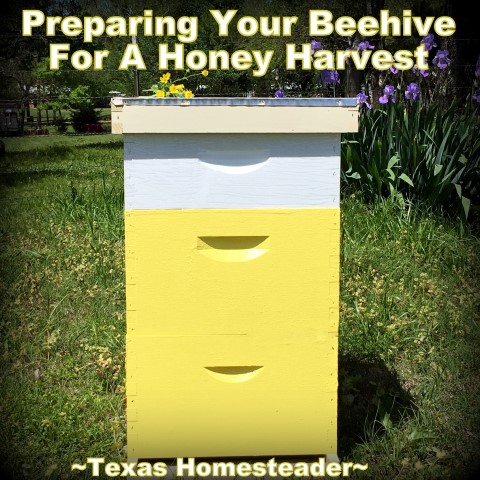
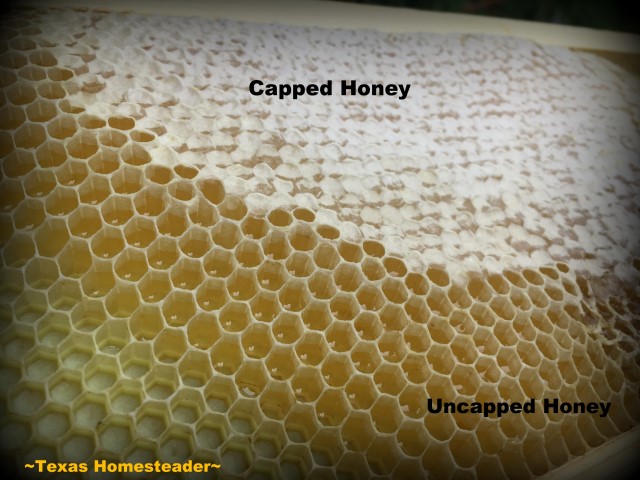
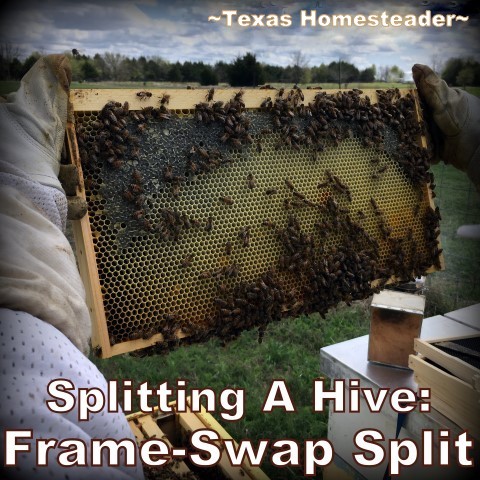
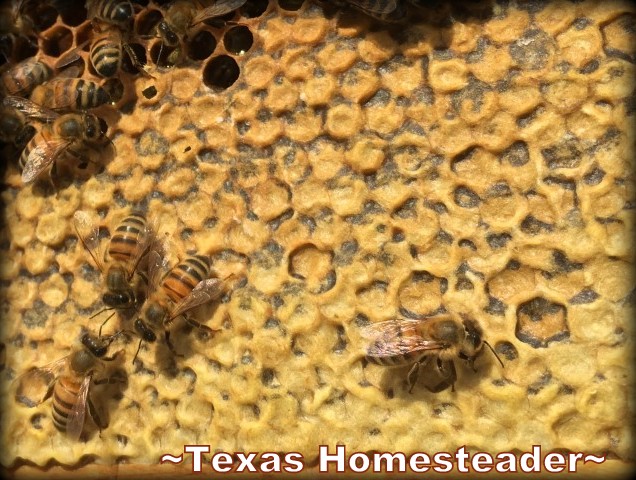
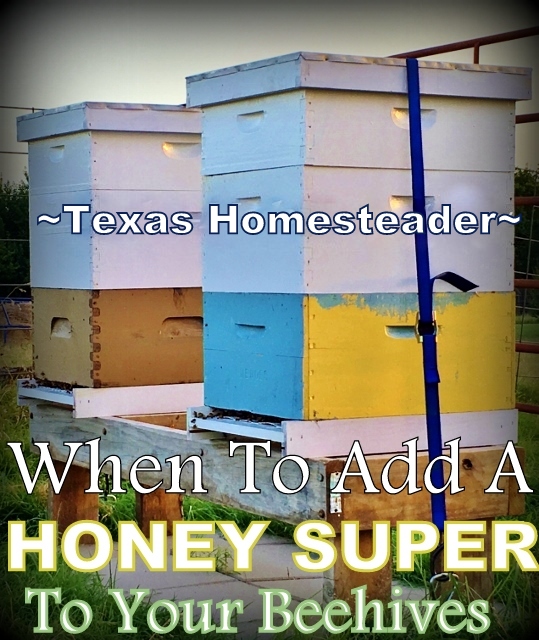

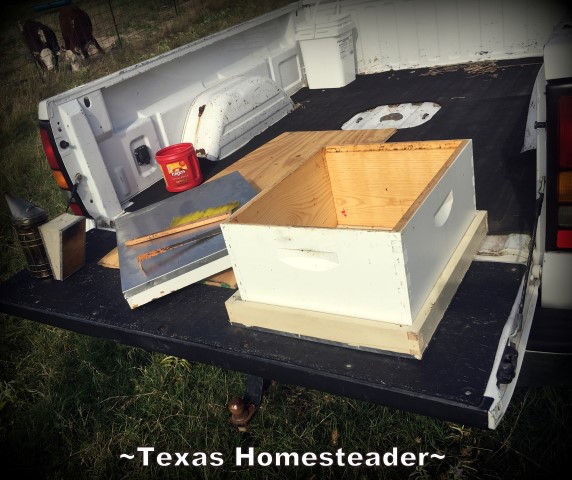



Thank you for sharing all these steps with us! I don’t live where I can have bees, or any farm animals, yet. But I’m hoping to get there eventually, & I like getting a basic idea of what I can look forward to
It’s my pleasure to share what I know (so far) about beekeeping. There’s always more to learn! And each beekeeper will do things a little differently based on their circumstances. But it’s so helpful to read how others do it so you can follow the path that works best for you. Thanks for being a valuable follower here on our little ole blog – your sweet comments are always so appreciated! ~TxH~